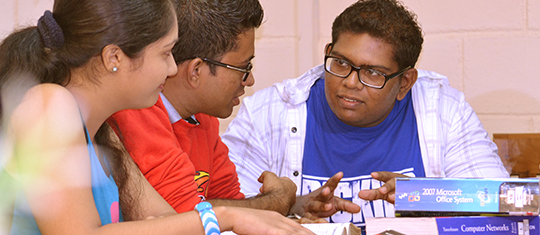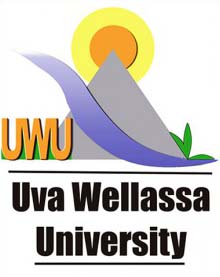Volume 01 Issue 01
01.Recognition of Vowels for Sri Lankan Traditional Pirith Chanting Using Formant Variation
M.A.C.P. Gunawardana*, S.S.N. Gamage
INFORMATION
Journal Title: Journal of Technology and Value Addition
Volume : 1
Issue : 1
Page : 1 – 7
Submitted: Novamber 15, 2018; Accepted: January 22, 2019
Correspondence : osheenchamee1989@gmail.com
ABSTRACT
Pirith is believed to be a doctrine preached by Lord Buddha and regarded to obtain protection from evil, promote health and well-being. Voice source produces a harmonic series, consisting of the fundamental frequency, F0 and harmonic frequencies called as formants, Fn. Vowels can be mapped using the relationship between lip opening width to the first formant frequency, F1 and tongue constriction width to second formant frequency, F2. This work is dedicated to developing phonetic picture on Pirith chants and analyze acoustic properties using computer-aided tools. As reported by several other studies, characteristic vowels and high frequency formants are identified in chanting in contrast to normal speaking. The motive of this study is to investigate vowel distribution of Pirith chants with the aim of special pattern recognition. Samples of Ratana, Karaneeya and Angulimala Suttas recited by male monk chanters were recorded using high precision microphone array and 15 samples of each Sutta were analyzed. Recorded samples were then subjected to splitting of smaller voiced segments of frame length 10 ms using sampling rate of 44.1 kHz. In the computational speech model, a preemphasis filter is applied to the sampled time series of voiced segment to cancel out the effect of glottis. Then frame-by-frame analysis was used with hamming windows and liner predictive coding (LPC) and auto correlation to extract the formant values. The vowel distribution reveals that a higher number of open vowels are articulated in Pirith chanting with totally disuse of closed vowels.
Keywords: Formant frequencies, Vowels
02. An Eco-Friendly Approach to Purify Reject Water from a Reverse Osmosis Treatment Plant
G.R.P.S. Karunarathne1*, S.M.W. Ranwala2
INFORMATION
Journal Title: Journal of Technology and Value Addition
Volume : 1
Issue : 1
Page : 8-18
Submitted: January 4, 2019; Accepted: January 22, 2019
Correspondence : prabodhasajee@yahoo.com
ABSTRACT
Purifying wastewater rejected from the Reverse Osmosis (RO) treatment plants is one of the challenges faced by industries. Wastewater consists of potential contaminants rejected from the RO treatment, referred as RO reject water. The study focuses phytoremediation technology where aquatic plants are used to absorb contaminants in RO reject water. The water hyacinth (Eichorrnia crassipes) and water lettuce (Pistia stratiotes) were selected as floating aquatic plants. Change in water quality before and after being exposed to plants and phytoaccumulation capacity of plants after eight weeks were investigated in the study. Contaminants of RO reject water were successfully removed by aquatic plants only within first four weeks (phase I). A higher reduction in concentration of total hardness, calcium hardness, alkalinity and ions was identified in the treatment tanks compared to control, filled with RO product. The removal of ions decreased with time within phase I, except for chloride and calcium hardness. Although the removal of total hardness, chloride, iron, magnesium, potassium and sodium in RO reject water was significantly (p < 0.5) greater in treatment tanks after first two weeks, only total hardness, alkalinity, iron and sulphate removal were significantly (p < 0.5) higher with time within phase I. Both aquatic plants accumulated ions in biomass especially with a higher accumulation for magnesium, sodium and potassium. Therefore, the proposed water treatment system can be used to treat RO reject water, with regular harvesting of plants and new replacement at every four weeks to maintain the effectiveness of phytoremediation process.
Keywords: Chemical fertilizer use, Eco-friendly technologies, Expert perceptions, Paddy sector
3. Adoption of Eco-Friendly Technologies to Reduce Chemical Fertilizer Usage in Paddy Farming in Sri Lanka: An Expert Perception Analysis
N.A.K.R.D. Chandrasiri1, U.K. Jayasinghe-Mudalige1, R.S. Dharmakeerthi2, W.S. Dandeniya2 and D.V.S.S. Samarasinghe1
INFORMATION
Journal Title: Journal of Technology and Value Addition
Volume : 1
Issue : 1
Page : 19-30
Submitted: Novamber 17, 2018; Accepted: January 22, 2019
Correspondence : udith@wyb.ac.lk
ABSTRACT
This paper explores the “experts point of view” on the possibility of a (1) package of Eco Friendly Technologies (EFTs) comprised of „Slow release fertilizer‟, „Organic carbon‟ and „Microbes‟ and incorporated those into the root ball of the rice plant at the nursery stage and then healthy seedlings are established in the paddy fields by way of „Parachute Technology‟ to reduce the chemical fertilizer use in two common seed establishment methods in paddy cultivation, i.e. (2) „Broadcasting‟, and (3) „Transplanting‟. The aspects those govern this behavior were identified in consultation with of a panel of scientists, and then classified into six major aspects, namely: (i) Level of „Acceptance‟ (AC); (ii) „Cost‟ of application in the field (CT); (iii) effect on the „Environment‟ (EN); (iv) expected „Performance‟ (PF); (v) existing „Regulation‟ (RG), and (vi) availability of related „Services‟ (SE). Having incorporated these into a questionnaire in the form of attitudinal statements (n=18) supported by a 10-point likert-scale, it was administered in-person with 32 experts to get their views. The data coded were subjected to the tests on Scale Reliability and Unidimensionality to evaluate their internal validity and reliability, and Aggregate Mean Scores were derived. The outcome of analysis show that experts perceive that EFT were in a “better” position in compared to the Broadcasting with regard to the aspects of: EN, PF and RG and “poor” with regard to: AC, SE and CT. In the context of EFTs vs. Transplanting, expert perceptions were “better” with regard to CT, AC and EN, but they perceive that EFTs are not in position to offset the benefits they enjoy in terms of SE, RG and PF. The outcome of analysis highlights the importance of generating private incentives for farmers to reduce monetary and transaction costs associated with use of EFTs and an appropriate institutional set up to regulate the fertilizer markets fully, as those non-competitive or distorted markets would demotivate farmers desire to go for this type of environmentally friendly technologies.
Keywords: Chemical fertilizer use, Eco-friendly technologies, Expert perceptions, Paddy sector
4. Analysis of Bioactive Properties of Fish Protein Hydrolysates from Scomber japonicus Fin Wastes
T.K. Ediriweera, A.L.Y.H. Aruppala, E.D.N.S. Abeyrathne*
INFORMATION
Journal Title: Journal of Technology and Value Addition
Volume : 1
Issue : 1
Page : 31-45
Submitted: November 28, 2018; Accepted: January 22, 2019
Correspondence : sandun@uwu.ac.lk
ABSTRACT
Scomber japonicus is a salience fish species used in canned fish processing. Its wastes are discarded, causing economic losses and environmental pollution. Study aims on producing bioactive Fish Protein Hydrolysates (FPH) utilizing fish wastes as a remedy. First, Scomber japonicus fin waste was collected and blended. Aqueous extracts of fish protein were produced with 04 different ratios as sample: distilled water, 1:1, 1:2, 1:3, 1:4. Best extraction was selected using 10% Sodium Dodecyle Sulphate Poly Acrylamide Gel Electrophoresis. Extracts were hydrolyzed using Papain, Pepsin, Trypsin and Protease enzymes (1:100) at 37ºC under their optimum pH conditions for 0, 3, 6, 9, 12 and 24 hours followed by heat inactivation at 100ºC for 15 minutes. Hydrolysates were lyophilized and analyzed for antioxidant activities by Thiobarbituric acid reactive substances (TBARS) assay and diphenyl picrylhydrazyl (DPPH) scavenging assay, metal chelation activity by Fe (II) chelating activity and antibacterial activities by agar well diffusion method. No significant difference was observed among 04 ratios in yield (p>0.05). 1:1 ratio was selected for hydrolysis experiments. None of the FPHs showed antioxidant properties with TBARS assay (p<0.05). Radical scavenging activity demonstrated a significant difference among treatments (p<0.05). Fe (II) chelating activity revealed Fe releasing instead of chelation (1.84, 13.99, 16.48, 1.84 %,). Antibacterial activities against E.coli and Salmonella spp. were highly positive in all hydrolysates showing best activity against both strains by Trypsin hydrolysate. This concludes the FPHs of water extracted Scomber japonicus fin wastes contain strong antibacterial activity, weak antioxidant activity and iron releasing properties.
Keywords: antibacteri, antioxidant, fish protein hydrolysates, metal chelating,
5. Colour Development of Geuda Stones after the Gas-Fired and Electrically Operated Furnace Heat Treatments
R.G.C. Jaliya1*, P.G.R. Dharmaratna2, K.B. Wijesekara3
INFORMATION
Journal Title: Journal of Technology and Value Addition
Volume : 1
Issue : 1
Page : 46- 51
Submitted: January 31, 2019; Accepted: February 05, 2019
Correspondence :jaliya@uwu.ac.lk
ABSTRACT
Geuda is a low-quality variety of corundum which can be converted into blue sapphire by heat treatment. Colour of the blue sapphire is mainly due to the presence of Iron (Fe) and Titanium (Ti) and their adjacent order in the lattice structure. The process of colouring is called Intervalence charge transfer, where an electron moves from one transition element to an another and the process absorb part of white light resulting in a blue colour. This study identified UV visible spectroscope absorptions behaviours of Geuda before and after gas-fired heat treatment using “Lakmini” furnace and electrically operated Lenton EHF 17/3 furnace. 6 Samples were randomly collected from Ratnapura, Niwithigala, Lunugala and Ambalangoda gemstone markets. Maximum temperature in Lakmini furnace was 1750°C with soaking time of 30 minutes under reduced environmental condition inside the furnace. Lenton EHF 17/3 was used with 1700 °C temperature and three different soaking times (three days, one week, one month). The optical absorption spectra were obtained using multiskan go microplate spectrophotometer through with SkanIt 4.1 software. Data were analysed using OriginPro 2018 software. A peak height difference was obtained at around 560-600nm between gas heated and combined heated (electric furnace heat treatment after gas furnace heat treatment) samples at maximum temperature with increased soaking times. This was maily due to the formation of [FeTi]6+ complex where the ate of formation of [FeTi]6+ was high with prolonged soaking. Therefore, results confirmed that the presence of both Iron (Fe) and Titanium (Ti) is required to produce the desired blue colour in heat treated Geuda stones.
Keywords: Geuda heat treatment, Intervalence charge transfer,UV visible spectroscopy,


